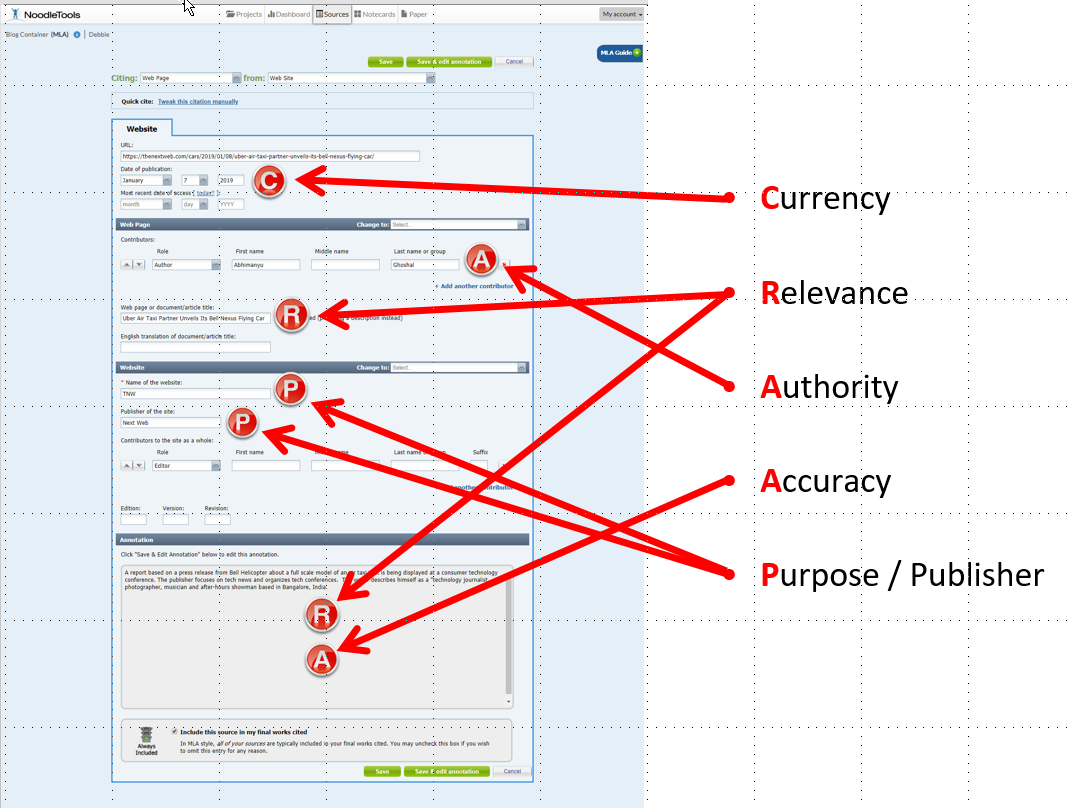Visualize the core and its containers

Like a Russian doll, a core work “nests” within one or more containers. A container expedites refinding because it pinpoints the precise version used.
The concept of containers is essential to MLA8 style because works-cited entries for all source types follow a predictable pattern.
Mini-lesson:
- Use MLA’s interactive generic template to build conceptual awareness of the common elements and their order within containers.
- Use NoodleTools’ source-specific templates to practice constructing entries for the exact source-types that students are likely to encounter.
Why are containers important?

During a roundtable at MLA’s 2019 annual conference, Rebecca Moore Howard of The Citation Project showed the first page of a student’s works cited list, noting that the publisher had been omitted from all entries. While she could only hypothesize why the student omitted this container, she was clear about its effect. She argued that this works cited list showed that source evaluation was absent: “Here we see how completely random are the student’s source choices.” The rhetorical context is missing.
What is a rhetorical context?
The context is what surrounds a source – including where it is accessed or located. Publishers and their platforms are bounded by different norms, conventions, affordances and limitations. The author’s communication choices are shaped by the publishing platform, as well as the audience and occasion for a piece of writing. Voice, word choice, sentence structure, the kinds of evidence and arguments, and the visual design are all rhetorical choices within a context. If a student extracts and uses evidence from sources without taking into account how the author shapes the context to the context in which it is published, the student will fall short of constructing a coherent argument.
Mini-lesson: Open your NoodleTools account and download this works cited list with three sources about why some people take pleasure from the misfortune of others. Compare how the publishing context has influenced the author’s rhetoric.

In NoodleTools, when students identify the “platform of publication” as the container, it can trigger what Sam Wineburg at Stanford History Education Group has termed lateral reading, a heuristic used by fact-checkers to judge a publisher’s credibility. The container is a software “nudge” to do a quick judgement call. Is the publisher associated with a particular ideology or organization? Over time, entering elements in the form can become a rule of thumb for an evaluation check.
Do all sources have containers?
The MLA Style Center shows examples of sources with and without containers. If the source is “contained,” it means that an organization or sponsor has contributed to its creation. For example, a web page that links to a source is not a “platform of publication.” It is merely pointing to access, a “passive conduit,” not a publisher. Below are examples of how platforms are sometimes containers and, under other circumstances, merely conduits
Search engines
- Online stores like Amazon, Google and Apple are NOT containers when they act as vehicles, driving you to a company or product on an external site.
- But they ARE containers when they publish content like Amazon’s author bio page, Google’s privacy policy or technical specifications for an Apple watch.
Portals and pathfinders
- Curated portals like Twitter, Pinterest and LibGuides are NOT containers when they link to content published elsewhere.
- But they ARE containers when they publish content like a researcher’s Tweet on notecard organization, a woodturner’s Pinterest of completed projects or a librarian’s LibGuide advice on when to summarize, paraphrase or quote.
Check student understanding:
- Is the “Knowledge Panel” search result [Google / Bing] a container?
- Is the Internet Archive a container?
- Is Encyclopaedia Britannica a container?
How can students practice applying their understanding of containers?

Focus on source types that students will encounter in their own research. For example, since anthologies are often cited in English and Humanities, students could practice assembling elements for a two-container short work (e.g., essay, story, poem) in an anthology (1) within a database (2) using this NoodleTools’ source-specific template.
Why don't students document publishers correctly?
At MLA’s 2019 annual meeting, researchers from LILAC Group, Citation Project, and Project Information Literacy discussed their ongoing investigation of college-students’ information literacy and research-based writing. The Citation Project has found abundant evidence that students document publishers incorrectly, but the researchers can only hypothesize about the reason for this behavior. For example, omitting or misidentifying the publisher could be a result of:
- failing to understand or adhere to MLA style, in which case the teacher could simply lower the student’s grade;
- copying from an incorrect model which, itself, omitted the publisher, in which case researchers should see the error replicated throughout the paper;
- confusing the publisher with other names (e.g., Springer vs. Nature or EBSCO vs. Points of View Reference Center), in which case students’ writing will not consider the context of the information they use.
The Citation Project is initiating a new research project to investigate student beliefs, their writing processes and their intentions in order to learn more about the cause of these errors. In the future, insights from that work could help educators match instructional interventions more precisely to students’ confusion, misconceptions and motivations.
Teaching the value of container information
Like building a Magic Deck, choosing entries for a works cited list should be a strategic process. The writer’s goal is to select sources that an audience will see as powerful, believable and relevant – a “winning” argument that underscores the writer’s authority.
NoodleTeach scenario
You have been writing a grant that will address inequality and have found the perfect Martin Luther King, Jr. quote to begin the proposal. Which of these four sites is the most strategic container (site publisher) to cite in your Ford Foundation grant – and why?
- Rose Robinson’s Tweet
- Brainy Quotes Web page
- A Constitution Daily Blog entry
- A draft chapter of King’s sermon in the King Papers Archive
